The Effect of Topographic Correction on Forest Tree Species Classification Accuracy
Abstract
:1. Introduction
2. Materials and Methods
2.1. Study Area
2.2. Data
2.2.1. Satellite Data
2.2.2. Digital Elevation Model
2.2.3. Subcompartment Data
2.3. Methods
2.3.1. Topographic Correction Model
2.3.2. Evaluation of the Topographic Correction
2.3.3. Method of Tree Species Classification
2.3.4. Evaluation of the Effectiveness of Different Topographic Correction Models on Tree Species Classification
3. Results
3.1. Effectiveness of the Topographic Correction Models
3.1.1. Visual Evaluation of the Topographic Correction
3.1.2. Analysis of Band Information before and after Topographic Correction
3.1.3. Effectiveness of Topographic Correction on Tree Species Reflectivity
3.1.4. Stability Analysis of Topographic Correction
3.1.5. Analysis of Correlations among the IC, NIR Band and Red Band of Different Tree Species before and after Correction
3.2. Topographic Correction Effectiveness on Tree Species Classification
3.2.1. Classification Results of Tree Species and Accuracy Evaluation
3.2.2. Topographic Correction Effectiveness on Tree Species Classification in Shaded Areas
3.2.3. Effect of Topographic on Classification Inconsistency Rate
4. Discussion
5. Conclusions
Author Contributions
Funding
Conflicts of Interest
References
- Scott, C.T.; Köhl, M.; Schnellbächer, H.J. A comparison of periodic and annual forest surveys. For. Sci. 1999, 45, 433–451. [Google Scholar]
- Immitzer, M.; Atzberger, C.; Koukal, T. Tree species classification with random forest using very high spatial resolution 8-band worldview-2 satellite data. Remote Sens. 2012, 4, 2661–2693. [Google Scholar] [CrossRef] [Green Version]
- Yu, Y.; Li, M.Z.; Fu, Y. Forest type identification by random forest classification combined with spot and multitemporal Sar data. J. For. Res. 2018, 29, 1407–1414. [Google Scholar] [CrossRef]
- Ke, Y.; Quackenbush, L.J.; Im, J. Synergistic use of quickbird multispectral imagery and lidar data for object-based forest species classification. Remote Sens. Environ. 2010, 114, 1141–1154. [Google Scholar] [CrossRef]
- Iizuka, K.; Tateishi, R. Estimation of CO2 sequestration by the forests in Japan by discriminating precise tree age category using remote sensing techniques. Remote Sens. 2015, 7, 15082–15113. [Google Scholar] [CrossRef] [Green Version]
- Kozoderov, V.V.; Dmitriev, E.V.; Melnik, P.G.; Donskoi, S.A. Evaluation of the species composition and the biological productivity of forests based on remote sensing data with high spatial and spectral resolution. Izv. Atmos. Ocean. Phys. 2018, 54, 1374–1380. [Google Scholar] [CrossRef]
- Liu, A. Study on the Theory and Method of Annual Monitoring of Forest Resources. Ph.D. Thesis, Nanjing Forestry University, Nanjing, China, 2006. [Google Scholar]
- Yu, X.Y.; Zhao, G.X.; Chang, C.Y.; Yuan, X.J.; Heng, F. Bgvi: A new index to estimate street-side greenery using baidu street view image. Forests 2019, 10, 3. [Google Scholar] [CrossRef] [Green Version]
- Lu, D. Integration of vegetation inventory data and Landsat Tm image for vegetation classification in the Western Brazilian Amazon. For. Ecol. Manag. 2005, 213, 369–383. [Google Scholar] [CrossRef]
- Schuck, A.; Päivinen, R.; Häme, T.; Van Brusselen, J.; Kennedy, P.; Folving, S. Compilation of a European forest map from Portugal to the Ural Mountains based on earth observation data and forest statistics. For. Policy Econ. 2003, 5, 187–202. [Google Scholar] [CrossRef]
- Immitzer, M.; Vuolo, F.; Atzberger, C. First experience with Sentinel-2 data for crop and tree species classifications in Central Europe. Remote Sens. 2016, 8, 166. [Google Scholar] [CrossRef]
- Grabska, E.; Hostert, P.; Pflugmacher, D.; Ostapowicz, K. Forest stand species mapping using the Sentinel-2 time series. Remote Sens. 2019, 11, 1197. [Google Scholar] [CrossRef] [Green Version]
- Chiang, S.-H.; Valdez, M. Tree species classification by integrating satellite imagery and topographic variables using maximum entropy method in a Mongolian forest. Forests 2019, 10, 961. [Google Scholar] [CrossRef] [Green Version]
- Vanonckelen, S.; Lhermitte, S.; Van Rompaey, A. The effect of atmospheric and topographic correction methods on land cover classification accuracy. Int. J. Appl. Earth Obs. Geoinf. 2013, 24, 9–21. [Google Scholar] [CrossRef] [Green Version]
- Moreira, E.P.; Valeriano, M. Application and evaluation of topographic correction methods to improve land cover mapping using object-based classification. Int. J. Appl. Earth Obs. Geoinf. 2014, 32, 208–217. [Google Scholar] [CrossRef]
- Zhu, X.Y.; Sun, M.W.; Wang, S.G.; Yu, L.; Chen, Q.; Wang, Y. Correction of false topographic perception phenomenon based on topographic correction in satellite imagery. IEEE Trans. Geosci. Remote Sens. 2017, 55, 468–476. [Google Scholar] [CrossRef]
- Galvao, L.S.; Breunig, F.M.; Teles, T.S.; Gaida, W.; Balbinot, R. Investigation of terrain illumination effects on vegetation indices and Vi-derived phenological metrics in subtropical Deciduous forests. Gisci. Remote Sens. 2016, 53, 360–381. [Google Scholar] [CrossRef]
- Vazquez-Jimenez, R.; Romero-Calcerrada, R.; Ramos-Bernal, R.N.; Arrogante-Funes, P.; Novillo, C.J. Topographic correction to Landsat imagery through slope classification by applying the Scs plus C method in mountainous forest areas. ISPRS Int. J. Geo Inf. 2017, 6, 287. [Google Scholar] [CrossRef]
- Ghasemi, N.; Mohammadzadeh, A.; Sahebi, M.R. Assessment of different topographic correction methods in alos Avnir-2 data over a forest area. Int. J. Digit. Earth 2013, 6, 504–520. [Google Scholar] [CrossRef]
- Pimple, U.; Sitthi, A.; Simonetti, D.; Pungkul, S.; Leadprathom, K.; Chidthaisong, A. Topographic correction of Landsat Tm-5 and Landsat Oli-8 imagery to improve the performance of forest classification in the mountainous terrain of Northeast Thailand. Sustainability 2017, 9, 258. [Google Scholar] [CrossRef] [Green Version]
- Szantoi, Z.; Simonetti, D. Fast and robust topographic correction method for medium resolution satellite imagery using a stratified approach. IEEE J. Sel. Top. Appl. Earth Obs. Remote Sens. 2013, 6, 1921–1933. [Google Scholar] [CrossRef]
- Ba, A.; Laslier, M.; Dufour, S.; Hubert-Moy, L. Riparian trees genera identification based on leaf-on/leaf-off airborne laser scanner data and machine learning classifiers in Northern France. Int. J. Remote Sens. 2020, 41, 1645–1667. [Google Scholar] [CrossRef]
- Liu, S.; Peng, G.; Panwei, L.; Xiang, N.; Bing, W. An ecosystem services assessment of Tai mountain. Acta Ecol. Sin. 2017, 37, 3302–3310. [Google Scholar]
- Lian, X. Study on Natural Regeneration and Sapling Distribution of Platycladus Orientalis Plantation in Mount Tai. Master’s Thesis, Shandong Agricultural University, Shandong, China, 2014. [Google Scholar]
- Meng, Y.; Cao, B.H.; Dong, C.; Dong, X.F. Mount Taishan forest ecosystem health assessment based on forest inventory data. Forests 2019, 10, 657. [Google Scholar] [CrossRef] [Green Version]
- Schmidt, G.; Jenkerson, C.B.; Masek, J.; Vermote, E.; Gao, F. Landsat ecosystem disturbance adaptive processing system (Ledaps) algorithm description. In Open-File Report; U.S. Geological Survey: Reston, VA, USA, 2013. [Google Scholar]
- Gorelick, N.; Hancher, M.; Dixon, M.; Ilyushchenko, S.; Thau, D.; Moore, R. Google earth engine: Planetary-Scale geospatial analysis for everyone. Remote Sens. Environ. 2017, 202, 18–27. [Google Scholar] [CrossRef]
- Farr, T.; Paul, G.; Rosen, A.; Caro, E.; Crippen, R.; Duren, R.; Hensley, S.; Kobrick, M.; Paller, M.; Rodriguez, E.; et al. The shuttle radar topography mission. Rev. Geophys. 2007, 45, 361. [Google Scholar] [CrossRef] [Green Version]
- Meng, Y.; Cao, B.; Mao, P.; Dong, C.; Cao, X.; Qi, L.; Wang, M.; Wu, Y. Tree species distribution change study in Mount Tai based on Landsat remote sensing image data. Forests 2020, 11, 130. [Google Scholar] [CrossRef] [Green Version]
- Teillet, P.M.; Guindon, B.; Goodenough, D.G. On the slope-aspect correction of multispectral scanner data. Can. J. Remote Sens. 1981, 8, 84–106. [Google Scholar] [CrossRef] [Green Version]
- Duguay, C.; Ledrew, E.F. Estimating surface reflectance and albedo over rugged terrain from Landsat-5 thematic mapper. Photogramm. Eng. Remote Sens. 1992, 58, 551–558. [Google Scholar]
- Gu, D.; Gillespie, A. Topographic normalization of Landsat Tm images of forest based on subpixel sun-canopy-sensor geometry. Remote Sens. Environ. 1998, 64, 166–175. [Google Scholar] [CrossRef]
- Tan, B.; Jeffrey, G.; Masek, R.W.; Gao, F.; Huang, C.; Eric, F.; Vermote, J.; Sexton, O.; Ederer, G. Improved forest change detection with terrain illumination corrected Landsat images. Remote Sens. Environ. 2013, 136, 469–483. [Google Scholar] [CrossRef]
- Zhang, Z.M.; He, G.J.; Zhang, X.M.; Long, T.F.; Wang, G.Z.; Wang, M.M. A coupled atmospheric and topographic correction algorithm for remotely sensed satellite imagery over mountainous terrain. Gisci. Remote Sens. 2018, 55, 400–416. [Google Scholar] [CrossRef]
- Zhong, Y.; Liu, L.; Wang, J.; Yan, G. Application and analysis of Scs + C topographic radiometric correction model. Remote Sens. Land Resour. 2006, 14, 18–79. [Google Scholar]
- Macintyre, P.; van Niekerk, A.; Mucina, L. Efficacy of multi-season Sentinel-2 imagery for compositional vegetation classification. Int. J. Appl. Earth Obs. Geoinf. 2020, 85, 10. [Google Scholar] [CrossRef]
- Breiman, L. Random forests. Mach. Learn. 2001, 45, 5–32. [Google Scholar] [CrossRef] [Green Version]
- Li, M.; Im, J.; Beier, C. Machine learning approaches for forest classification and change analysis using multi-temporal Landsat Tm images over Huntington wildlife forest. Gisci. Remote Sens. 2013, 50, 361–384. [Google Scholar] [CrossRef]
- Becek, K.; Akgül, V.; Inyurt, S.; Mekik, Ç.; Pochwatka, P. How well can spaceborne digital elevation models represent a man-made structure: A runway case study. Geosciences 2019, 9, 387. [Google Scholar] [CrossRef] [Green Version]
- Conese, C.; Gilabert, M.A.; Maselli, F.; Bottai, L. Topographic normalization of Tm scenes through the use of an atmospheric correction method and digital terrain models. Photogramm. Eng. Remote Sens. 1993, 59, 1745–1753. [Google Scholar]
- Becek, K.; Borkowski, A.; Mekik, Ç. A study of the impact of insolation on remote sensing-based landcover and landuse data extraction. ISPRS Int. Arch. Photogramm. Remote Sens. Spat. Inf. Sci. 2016, 65–69. [Google Scholar] [CrossRef]
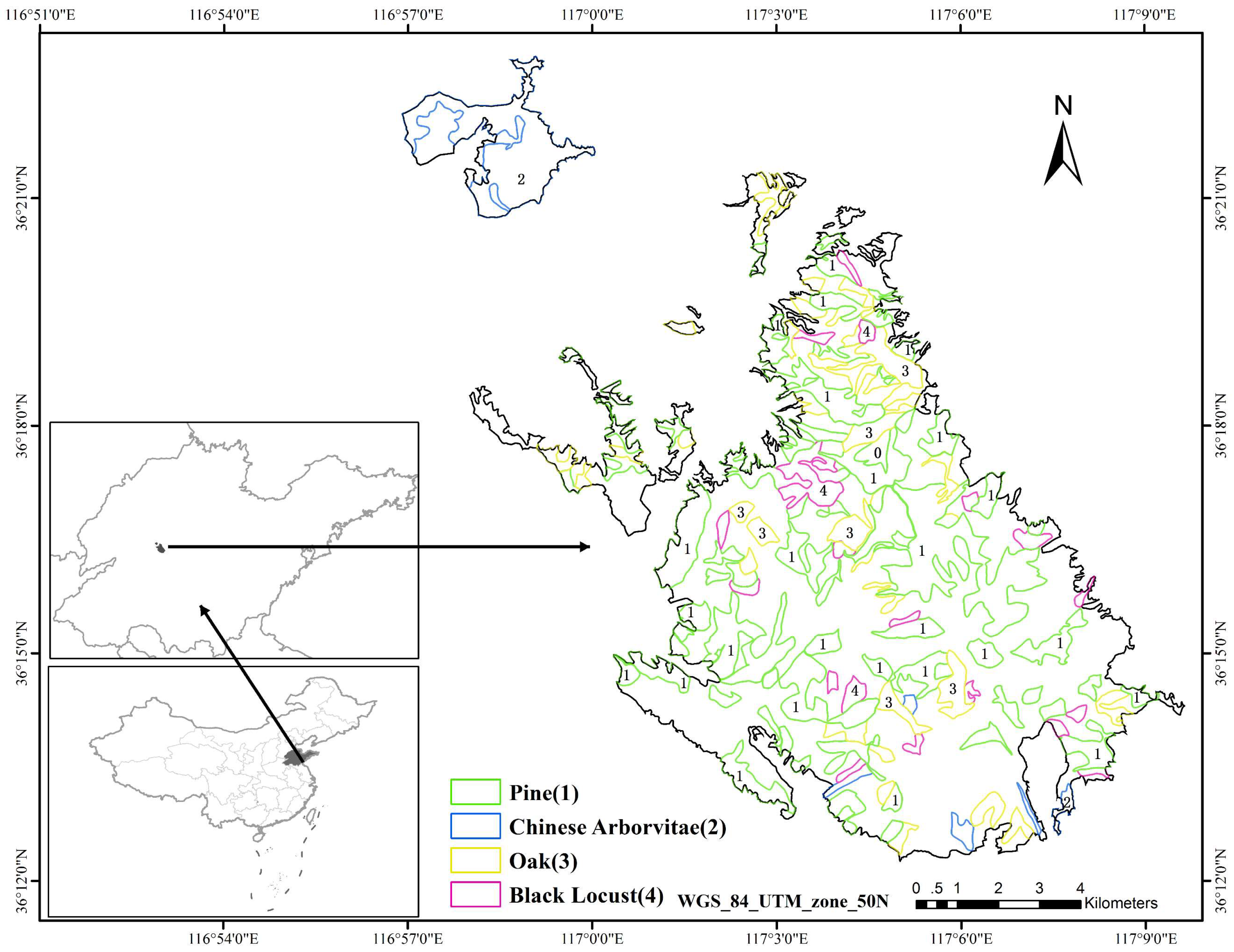

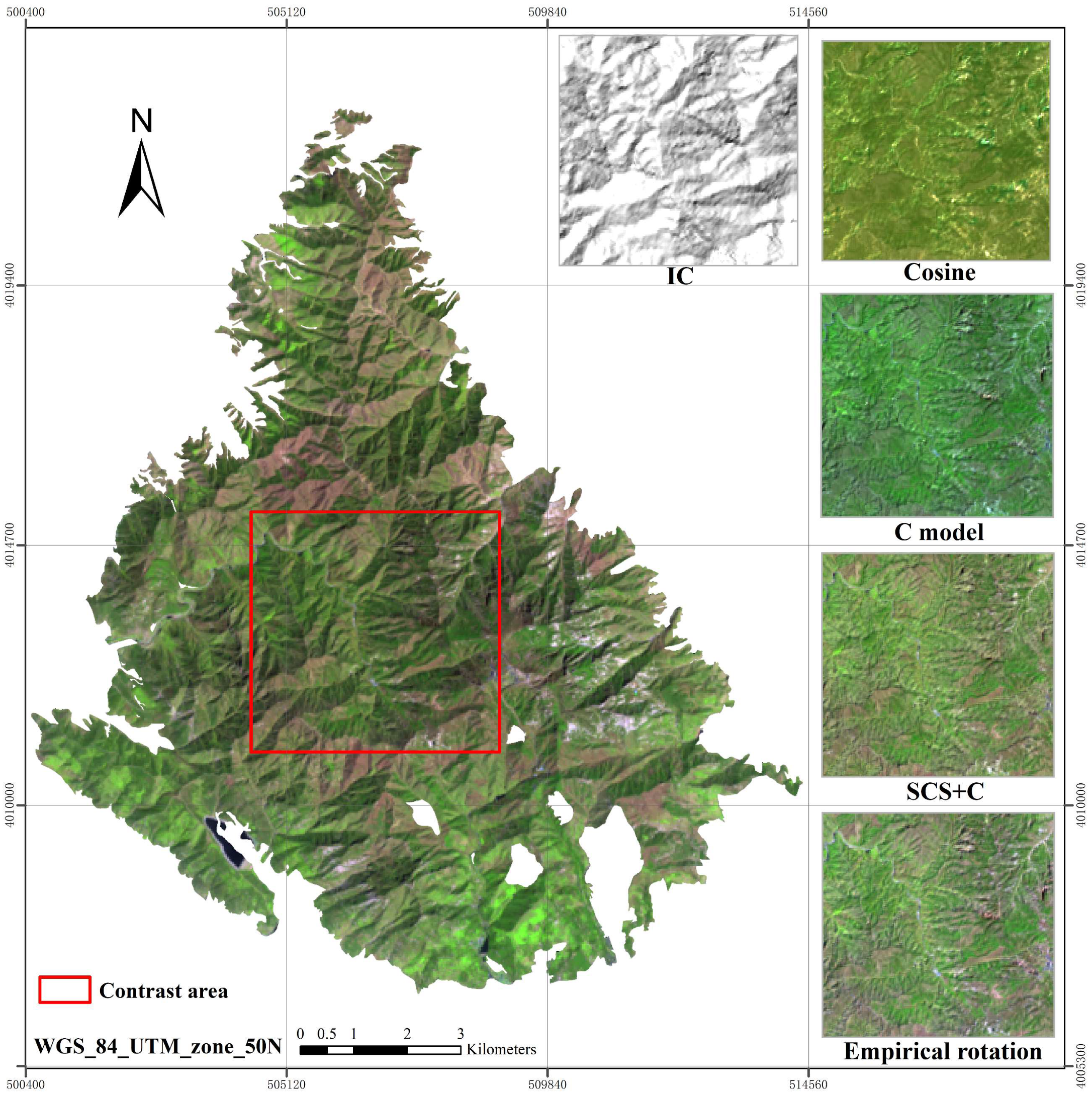
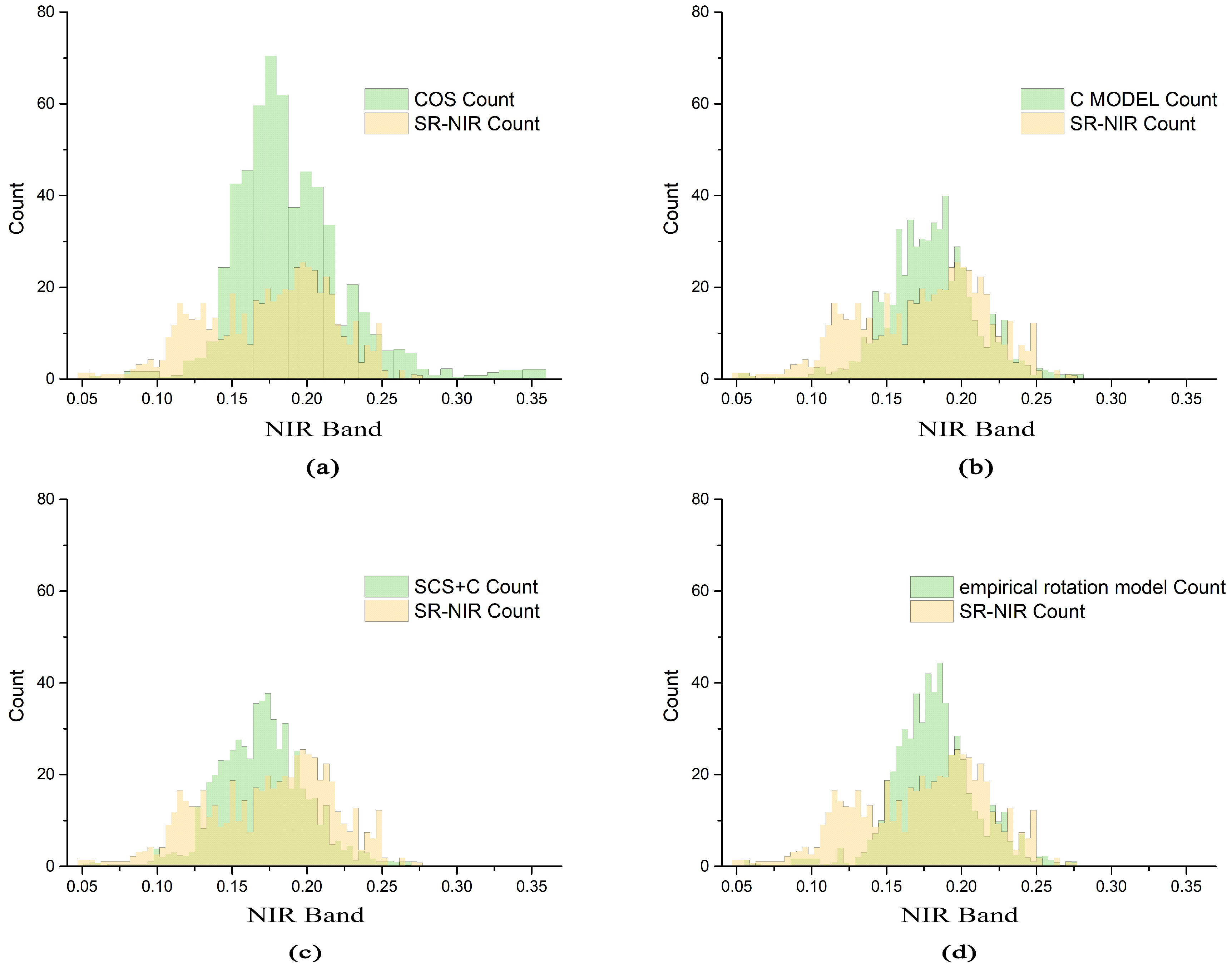


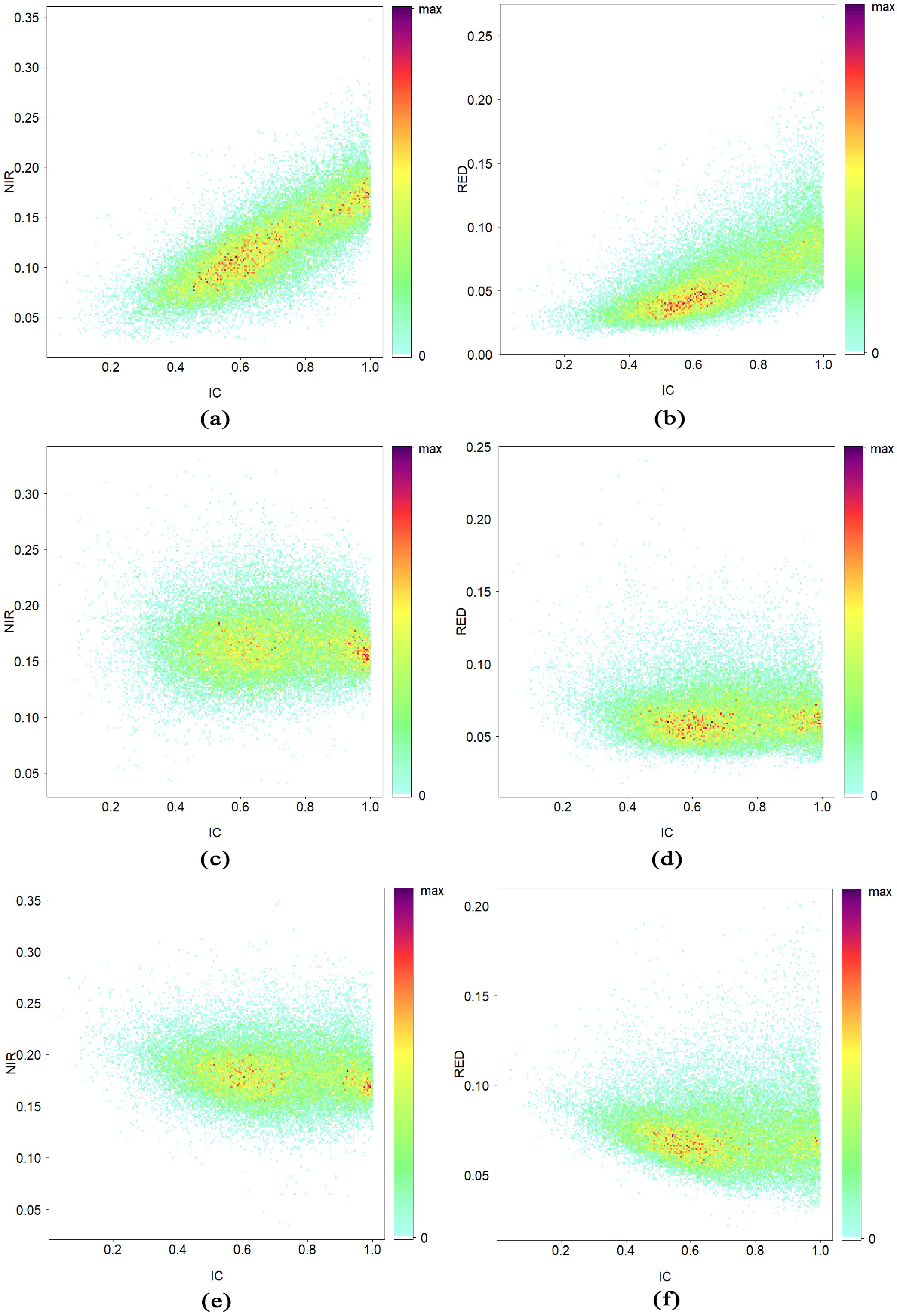

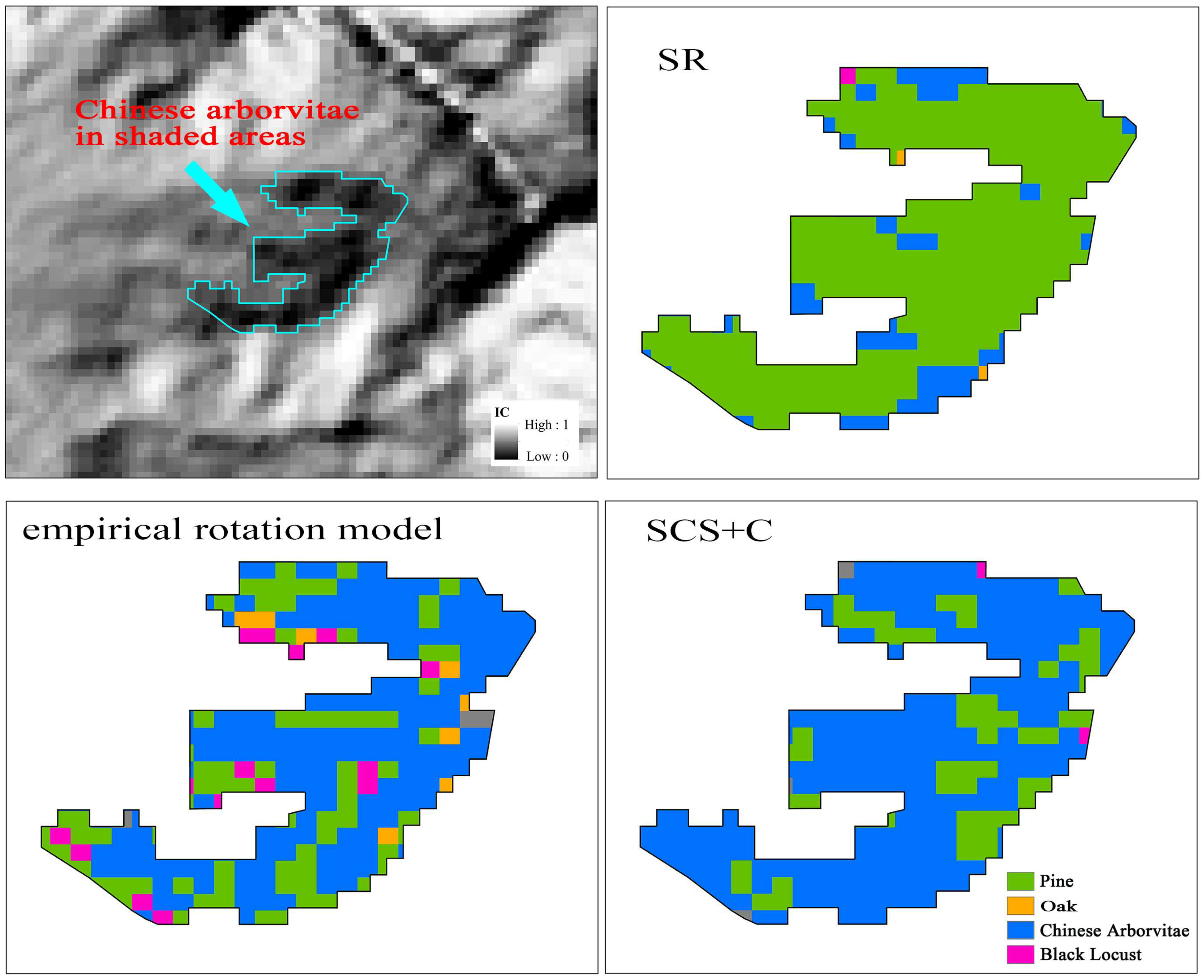
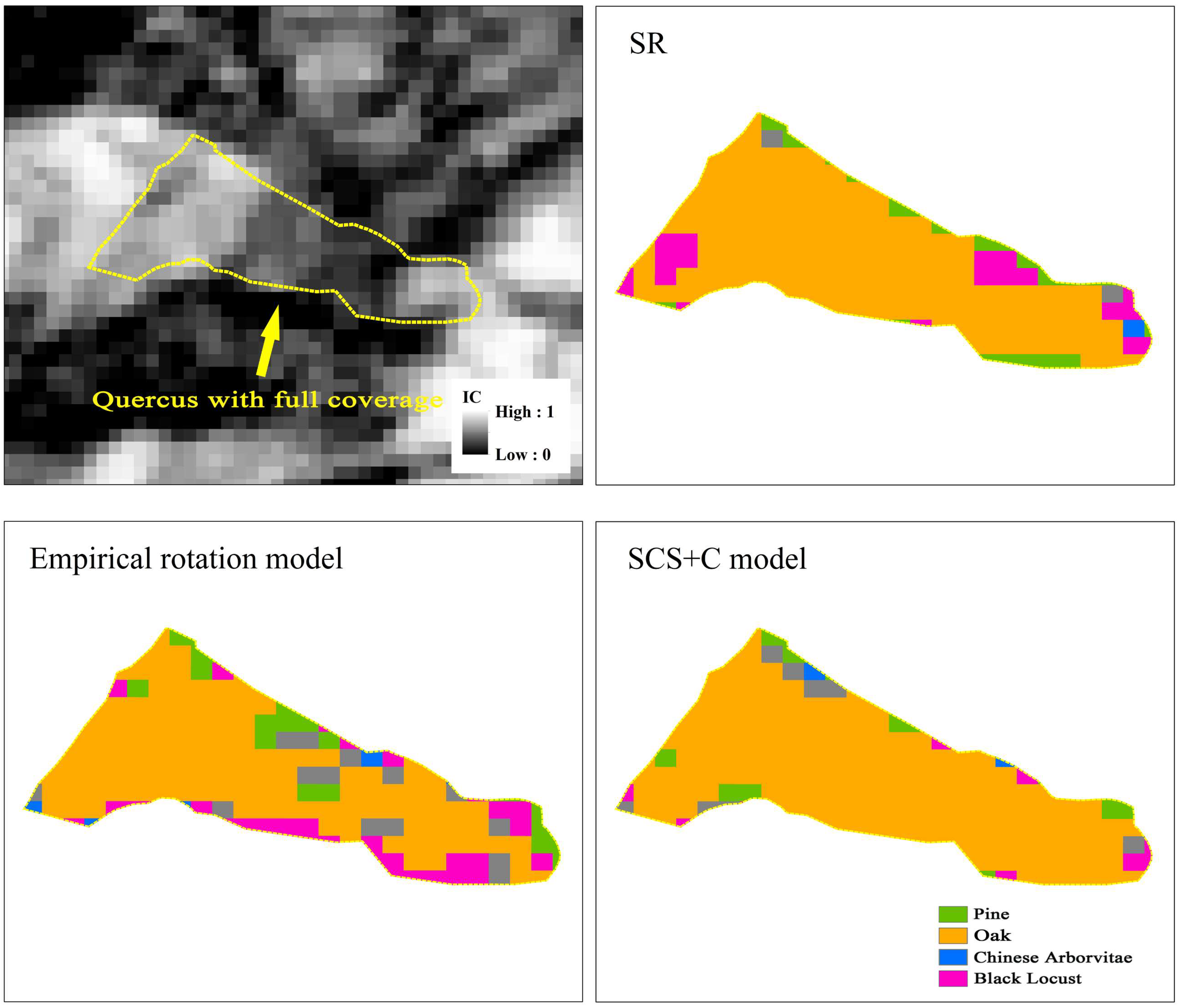
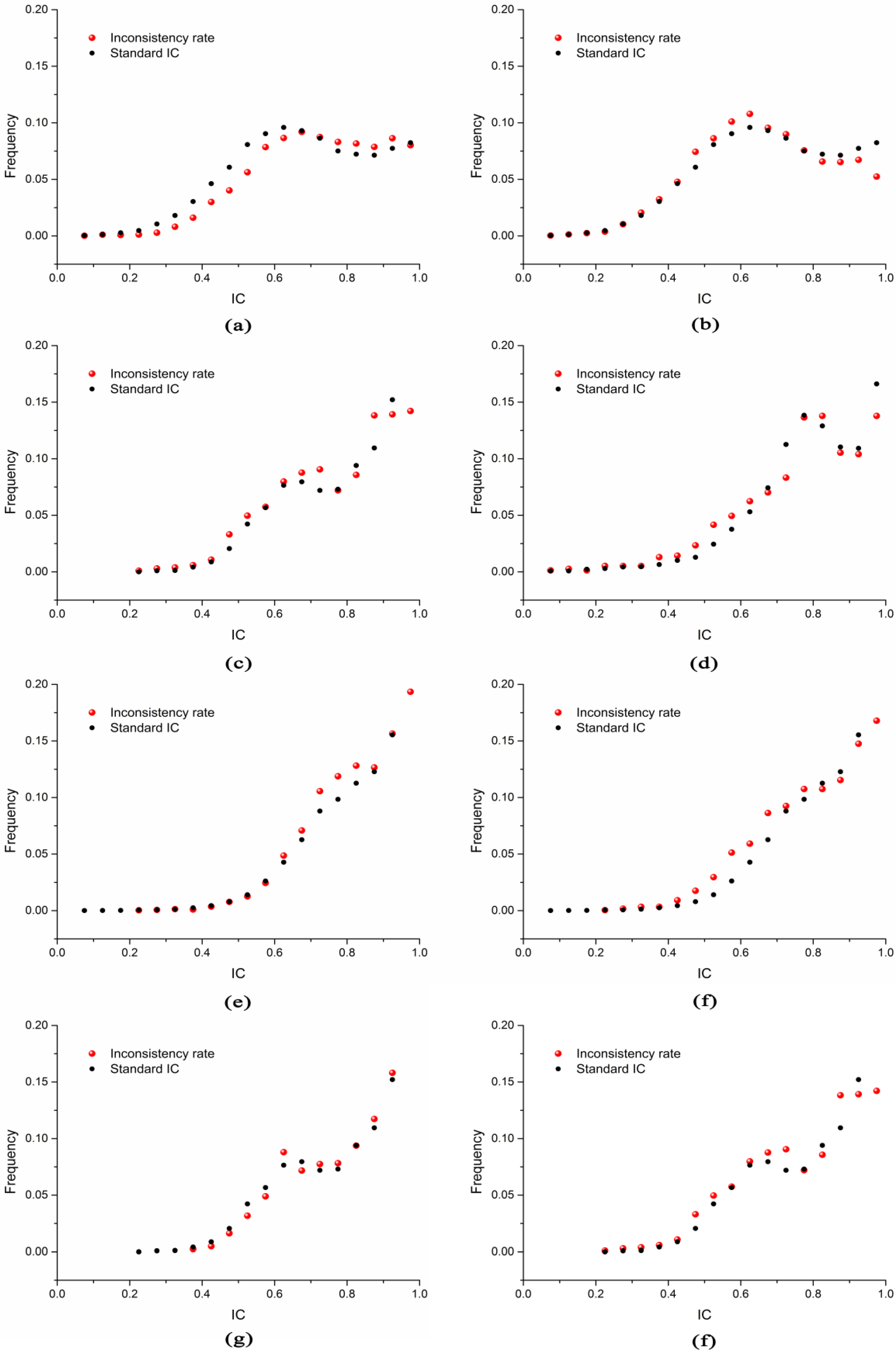
| Name | Units Scale | Wavelength (μm) | Description |
|---|---|---|---|
| Band2 | 0.0001 | 0.452–0.512 | blue |
| Band3 | 0.0001 | 0.533–0.590 | green |
| Band4 | 0.0001 | 0.636–0.673 | red |
| Band5 | 0.0001 | 0.851–0.879 | near infrared (NIR) |
| Band6 | 0.0001 | 1.566–1.651 | shortwave infrared 1 (SWIR1) |
| Band7 | 0.0001 | 2.107–2.294 | shortwave infrared 2 (SWIR2) |
| SR | Cosine Model | C Model | SCS+C Model | Empirical Rotation Model | |
|---|---|---|---|---|---|
| Blue | 0.013 | 0.008 | 0.009 | 0.009 | 0.008 |
| Green | 0.016 | 0.012 | 0.011 | 0.011 | 0.009 |
| NIR | 0.042 | 0.037 | 0.030 | 0.029 | 0.027 |
| Red | 0.022 | 0.014 | 0.015 | 0.015 | 0.013 |
| SWIR1 | 0.055 | 0.035 | 0.040 | 0.039 | 0.034 |
| SWIR2 | 0.044 | 0.030 | 0.033 | 0.032 | 0.028 |
| Tree Species | NIR | Red | ||||
|---|---|---|---|---|---|---|
| SR | SCS+C | Empirical rotation | SR | SCS+C | Empirical rotation | |
| Pine | 0.58 | 0.79 × 10−3 | 0.15 × 10−1 | 0.43 | 0.28 × 10−3 | 0.77 × 10−2 |
| Chinese arborvitae | 0.69 | 0.13 × 10−1 | 0.24 × 10−2 | 0.29 | 0.22 | 0.22 |
| Oak | 0.41 | 0.94 × 10−2 | 0.61 × 10−2 | 0.30 | 0.33 × 10−2 | 0.58 × 10−3 |
| Black locust | 0.47 | 0.80 × 10−5 | 0.85 × 10−2 | 0.44 | 0.13 × 10−2 | 0.60 × 10−3 |
| Shadowless Training Data | Overall Accuracy | Kappa | Full-Coverage Training Data | Overall Accuracy | Kappa |
|---|---|---|---|---|---|
| SR | 0.65 | 0.52 | SR | 0.76 | 0.68 |
| SCS+C model | 0.74 | 0.67 | SCS+C model | 0.79 | 0.73 |
| Empirical rotation model | 0.72 | 0.64 | Empirical rotation model | 0.77 | 0.70 |
| Tree Species | SR | SCS+C | Empirical Rotation | ||
|---|---|---|---|---|---|
| Area (m2) | Area (m2) | Gradient (%) | Area (m2) | Gradient (%) | |
| Pines | 57,028 | 58,647 | 2.84 | 58,981 | 3.424 |
| Chinese arborvitae | 27,515 | 26,101 | −5.14 | 26,779 | −2.67 |
| Oak | 21,438 | 22,631 | 5.56 | 21,801 | 1.69 |
| Black locust | 18,987 | 18,376 | −3.22 | 20,535 | 8.15 |
© 2020 by the authors. Licensee MDPI, Basel, Switzerland. This article is an open access article distributed under the terms and conditions of the Creative Commons Attribution (CC BY) license (http://creativecommons.org/licenses/by/4.0/).
Share and Cite
Dong, C.; Zhao, G.; Meng, Y.; Li, B.; Peng, B. The Effect of Topographic Correction on Forest Tree Species Classification Accuracy. Remote Sens. 2020, 12, 787. https://doi.org/10.3390/rs12050787
Dong C, Zhao G, Meng Y, Li B, Peng B. The Effect of Topographic Correction on Forest Tree Species Classification Accuracy. Remote Sensing. 2020; 12(5):787. https://doi.org/10.3390/rs12050787
Chicago/Turabian StyleDong, Chao, Gengxing Zhao, Yan Meng, Baihong Li, and Bo Peng. 2020. "The Effect of Topographic Correction on Forest Tree Species Classification Accuracy" Remote Sensing 12, no. 5: 787. https://doi.org/10.3390/rs12050787
APA StyleDong, C., Zhao, G., Meng, Y., Li, B., & Peng, B. (2020). The Effect of Topographic Correction on Forest Tree Species Classification Accuracy. Remote Sensing, 12(5), 787. https://doi.org/10.3390/rs12050787




